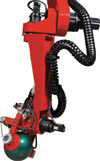

Bowling is a popular sport in the US. It is estimated that 70 million people go bowling in the course of a year.
In 2010 the United States Bowling Congress (USBC) sought the assistance of a high performance bowling robot, Enhanced Automated Robot Launcher (EARL), which was developed by robotics company, ARM Automation. A PC- and EtherCAT-based platform from Beckhoff ensured precise control of the robot.
The EARL bowling robot was developed to conduct research into the correlation between ball movement and scoring. It could replicate virtually any bowler’s style and help coaching staff to show players how to adjust to the ever changing bowling environment.
Optimum synchronisation and precision
The motion system consisted of a linear axis to position the ball across the width of the lane, a 5-axis positioning robot, a ball spinner and a release mechanism installed on a gripper. It may seem like a simple swing of the arm, but when the robot grips the bowling ball and bowls it down the lane, there are many parameters which need to be captured for a single throw test. A typical EARL test setting consists of the following:
* Orientation of the robot gripper relative to the ball’s centre of gravity.
* Release point of the ball relative to the bowling lane (height, position relative to foul line, position across the width of the lane, loft angle, ball trajectory).
* Ball release speed and rotation speed.
The biggest challenge for the mechanical and electrical control development was getting the timing of the bowling ball release. USBC required a speed of about 38 kph for the ball release. A delay of 1 ms equates to roughly a degree in difference for the ball loft and 12,7 mm difference relative to the foul line (if it goes over this line the bowl is out of bounds). Any additional dither and the ball can be thrown into the ceiling or slammed into the bowling lane.
Optimum synchronisation and precision were achieved through the distributed clock function of EtherCAT. This provided the precision to coordinate the external I/O with the control and position of the drives in the sub-millisecond range. The position of the robot’s end effector was communicated to the EtherCAT drives to determine the exact time at which the ball needed to be released. The position measurement was exceptionally precise, within 1 ms, and successfully created the correct loft of the ball each time. EARL was able to release a bowling ball within 250 s of a scan of the position.
Motion control based on TwinCAT
EARL required the ability to gather input from a wide range of devices and communicate easily with the drives in a flexible environment. EtherCAT allowed ARM to pull together different platforms with ease. The TwinCAT automation software coordinated the acquisition of I/O and position data from the drives, performed inverse kinematics, generated the next joint position commands and relayed the new position commands and data to the drives. ARM developed a kinematic transformation for EARL which was implemented in TwinCAT and was fed into the NC via the external set value generation. The motion control functions of TwinCAT were used for this. NC PTP allowed the motion axes to be controlled, and constantly monitored the status of the EtherCAT drives.
TwinCAT also monitored all the safety devices. In the event of a problem, the drives could immediately be disabled, allowing the robot to go into a safe state until the system was reset properly. The robot was enclosed in a protective cage with safety sensors, light curtains and safety relays installed all around to ensure optimum safety.
For more information contact Kenneth McPherson, Beckhoff Automation, +27 (0)11 795 2898, [email protected] , www.beckhoff.co.za
| Tel: | +27 11 795 2898 |
| Fax: | 086 603 6868 |
| Email: | [email protected] |
| www: | www.beckhoff.com |
| Articles: | More information and articles about Beckhoff Automation |

© Technews Publishing (Pty) Ltd | All Rights Reserved